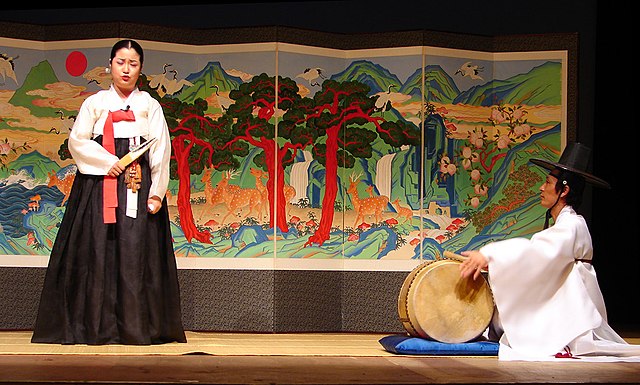Teochew literary reading (4) - Korean vs. Teochew readings of literary Chinese
This series of posts started off with the observation that Korean and Teochew have some uncanny similarities, and from there went on to explore the question of literary vs. colloquial pronunciations and the various historical “layers” in Teochew.
Let’s now compare, side by side, how a text in literary Chinese would be recited in Teochew literary pronunciation, and in Sino-Korean pronunciation.
Korean Pansori (musical storytelling) performance in Busan, South Korea. (Image source: Steve46814, CC BY-SA 3.0, via Wikimedia Commons)
In the following excerpts, characters with Teochew literary readings are marked in italics (the vernacular readings for the same character are also noted below).
The excerpts and Korean readings come from Lesson 1 of A New Practical Primer of Literary Chinese by Paul Rouzer (2007). I don’t speak Korean myself, so the Korean reading simply follows what is given in the book.
知命者不怨天,知己者不怨人。
K: ji myeong ja bu won cheon, ji gi ja bu won in.
T: di1 mêng6 zia2 bug4 uêng3 tiêng1, di1 gi2 zia2 bug4 uêng3 ring5.
M: zhī mìng zhě bù yuàn tiān, zhī jǐ zhě bù yuàn rén.
知 lit. di1, vern. zai1
命 lit. mêng6, vern. mian7
不 lit. bug4, gloss m6 唔
天 lit. tiêng1, vern. tin1
人 lit. ring5, gloss nang5 儂
禍生於欲得,福生於自禁。
K: hwa saeng eo yok deuk, bok saeng eo ja geum.
T: hua6 sêng1 e1 iog8 dêg4, hog4 sêng1 e1 ze6 gim3.
M: huò shēng yú yù dé, fù shēng yú zì jǐn.
生 lit. sêng, vern. sên1
欲 lit. iog8, gloss ain3 愛
聖人以心導耳目,小人以耳目導心。
K: seong in i sim do i mok, so in i i mok do sim.
T: sêng3 ring5 in2 sim1 dao6 re2 mag8, siou2 ring5 in2 re2 mag8 dao6 sim1.
M: shèng rén yǐ xīn dǎo ěr mù, xiǎo rén yǐ ěr mù dǎo xīn.
耳 lit. re2, vern. hin6
小 lit. siou2, vern. siê2
為善者天報以德。為不善者天報以禍。
K: wi seon ja cheon bo i deok. wi bu seon ja cheon bo i hwa.
T: ui5 siêng6 zia2 tiêng1 bo3 in2 dêg4. ui5 bug4 siêng6 zia2 tiêng1 bo3 in2 hua6.
M: wéi shàn zhě tiān bào yǐ dé, wéi bù shàn zhě tiān bào yǐ huò.
Posted on 2021-05-13 00:00:00 +0000
